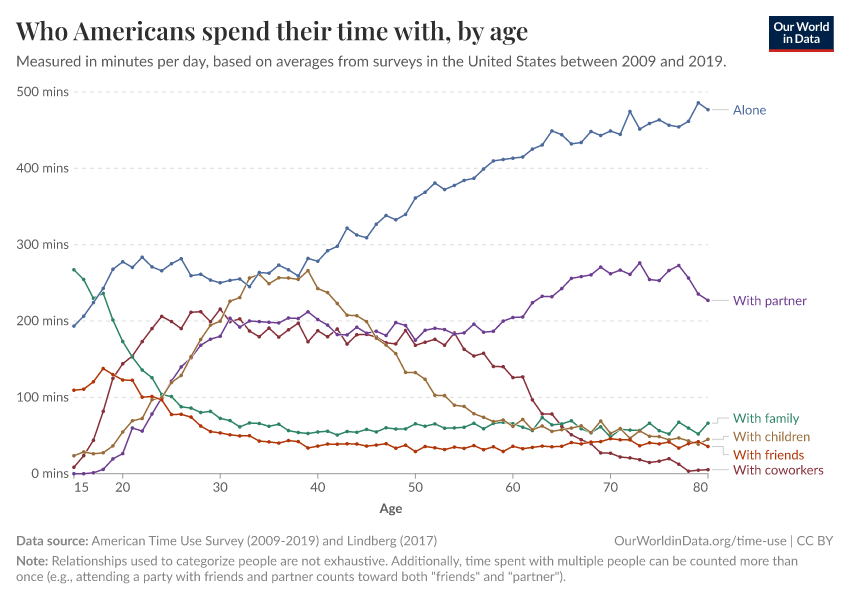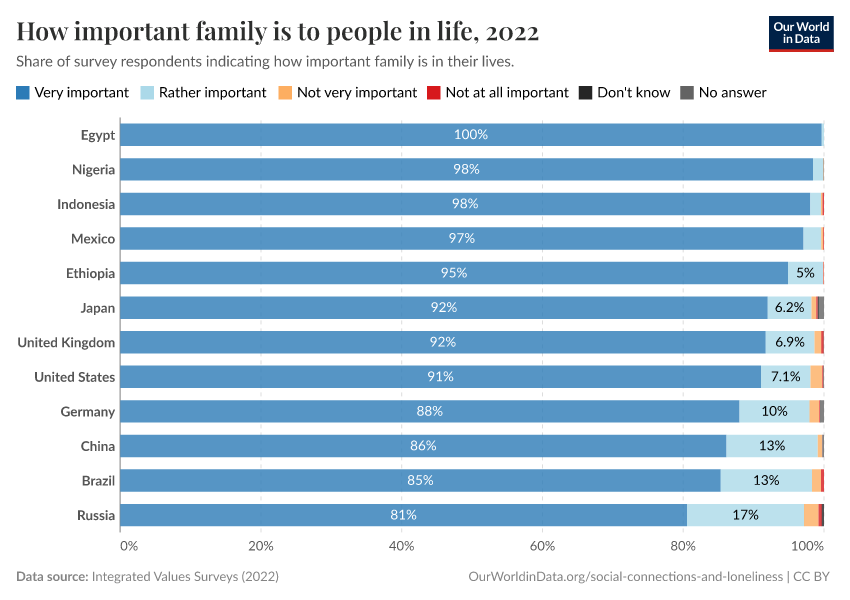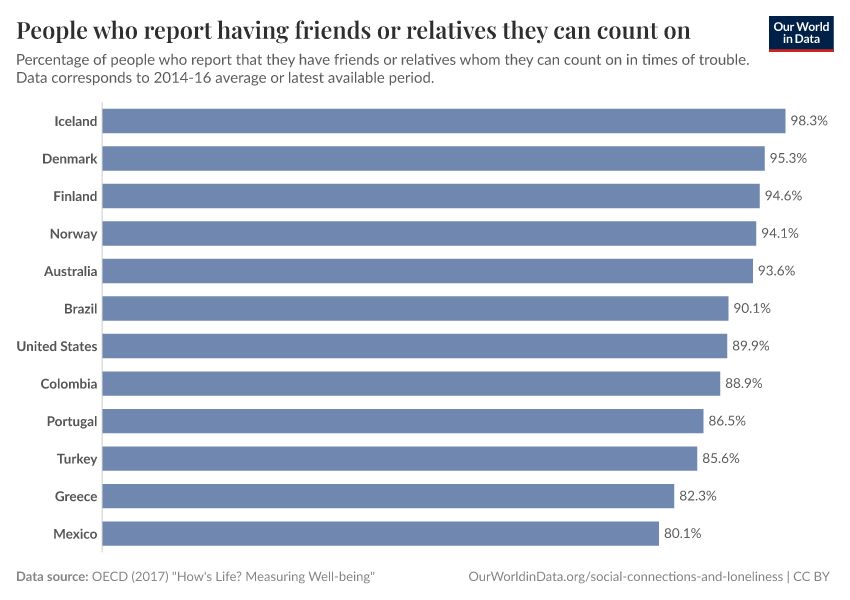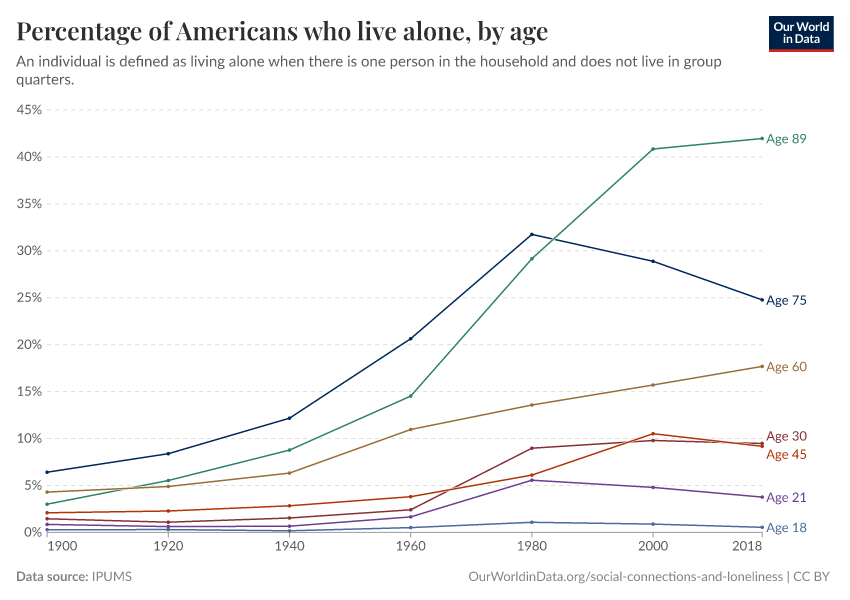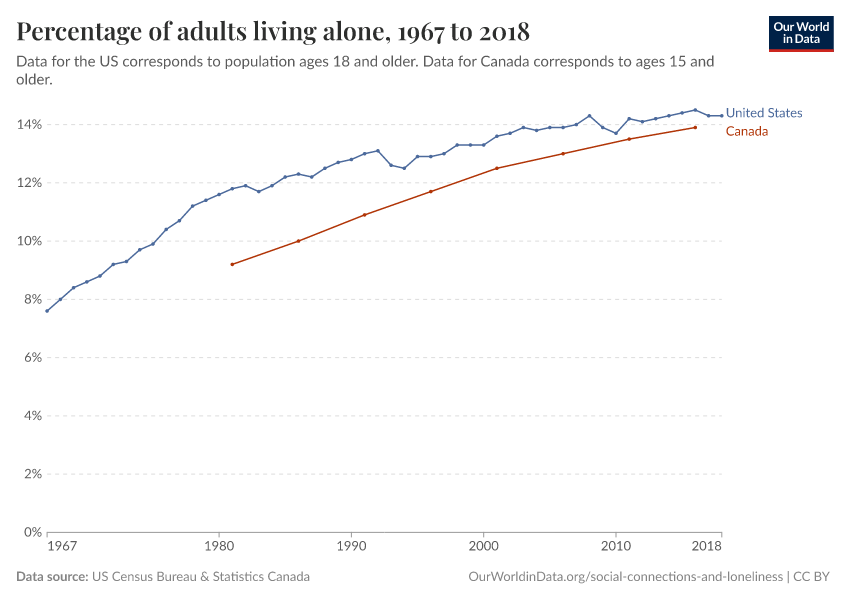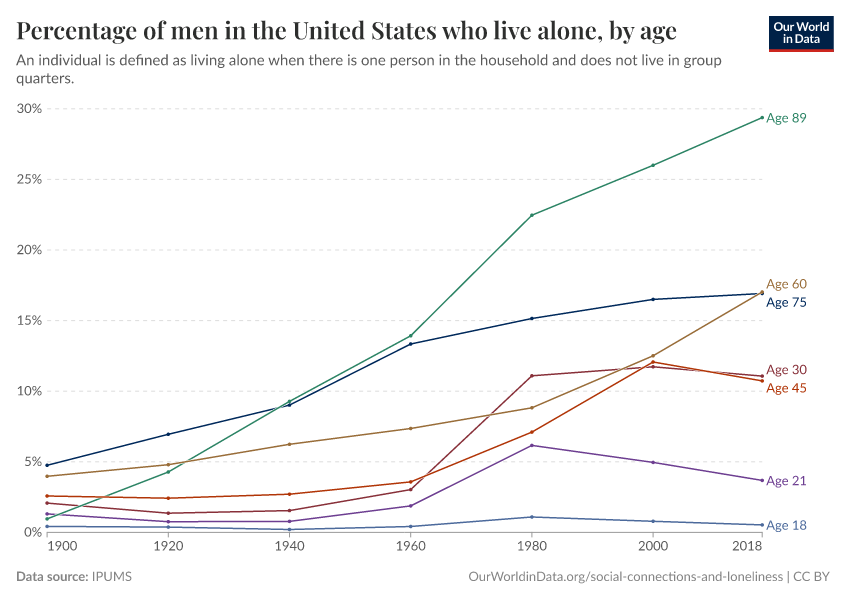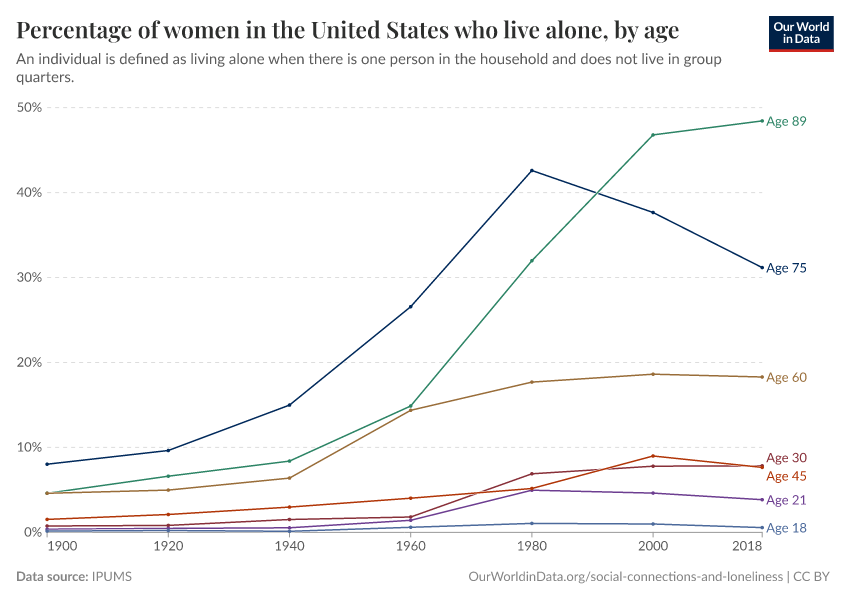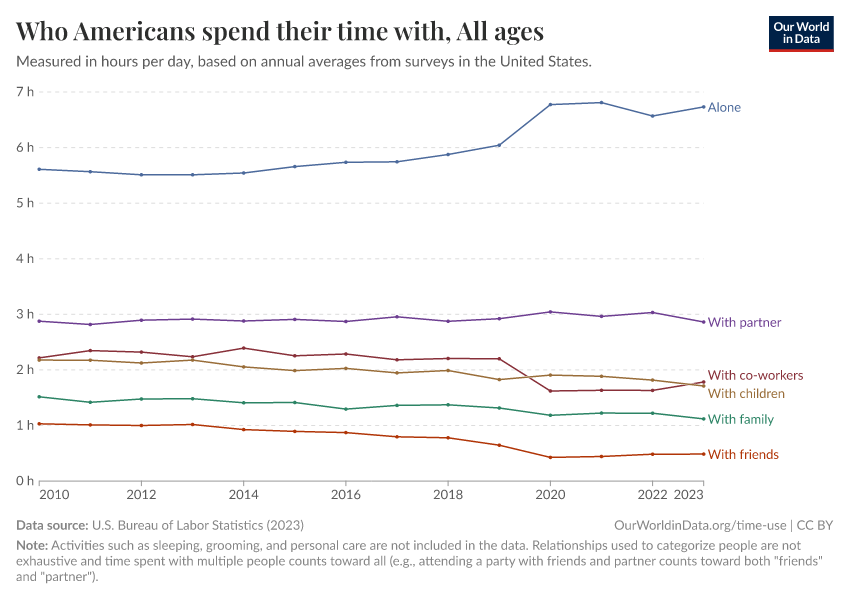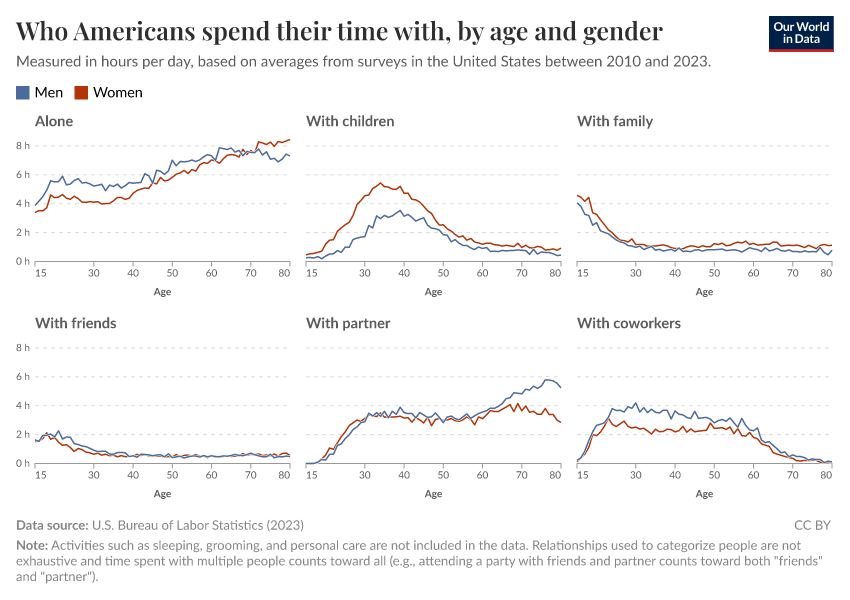Loneliness and Social Connections
Family and friends are important for our well-being. In this article, we explore data on loneliness and social connections and review available evidence on the link between social connections and well-being.
This article was first published in February 2020. We made minor changes to the text in March 2024.
Research shows that social connections are important for our well-being. Having support from family and friends is important for our happiness and health and is also instrumental to our ability to share information, learn from others, and seize economic opportunities.
In this article, we explore data on loneliness and social connections across countries and over time and review the available evidence on how and why social connections and loneliness affect our health and emotional welfare, as well as our material well-being.
Despite the fact that there is a clear link between social connections and well-being, more research is needed to understand causal mechanisms, effect sizes, and changes over time.
As we show here, oversimplified narratives that compare loneliness with smoking or that claim we are living in a 'loneliness epidemic' are wrong and unhelpful.
See all interactive charts on loneliness and social connections ↓
Related topics
Other research and writing on Loneliness and Social Connections on Our World in Data:
- Are Facebook and other social media platforms bad for our well-being?
- Are people more likely to be lonely in so-called 'individualistic' societies?
- Is there a loneliness epidemic?
- The importance of social networks for innovation and productivity
- The importance of personal relations for economic outcomes
- Who do we spend time with across our lifetime?
Social connections
How important are social connections for our health?
Dr. Vivek Murthy, former Surgeon General of the United States, recently wrote: “Loneliness and weak social connections are associated with a reduction in lifespan similar to that caused by smoking 15 cigarettes a day”.
This ‘15 cigarettes a day’ figure has been reproduced and reported in the news many times, under headlines such as “Loneliness is as lethal as smoking 15 cigarettes per day”.1
It is indeed quite a shocking comparison since millions of deaths globally are attributed to smoking every year, and back-of-the-envelope calculations published in medical journals say one cigarette reduces your lifespan by 11 minutes.
Here, we dig deeper to try to understand what the data and research tell us about the link between social relations and health. In a nutshell, the evidence is as follows:
- There is a huge amount of evidence showing individuals who report feelings of loneliness are more likely to have health problems later in their life.
- There is a credible theory and explanation of biological mechanisms whereby isolation can set off unconscious surveillance for social threats, producing cognitive biases, reducing sleep, and affecting hormones.
- It's very likely there is a causal link. Still, there is no credible experimental evidence that would allow us to have a precise estimate of the magnitude of the causal effect that loneliness has on key metrics of health, such as life expectancy.
- The fact that we struggle to pin down the magnitude of the effect of loneliness on health doesn't mean we should dismiss the available evidence. However, it does show that more research is needed.
Observational studies: A first look at the data
Measuring loneliness
Psychologists and social neuroscientists often refer to loneliness as painful isolation. The emphasis on pain is there to make a clear distinction between solitude – the state of being alone – and subjective loneliness, which is the distressing feeling that comes from unmet expectations of the types of interpersonal relationships we wish to have.
Researchers use several kinds of data to measure solitude and loneliness. The most common source of data are surveys where people are asked about different aspects of their lives, including whether they live alone, how much time they spend with other people in a given window of time (e.g., ‘last week’), or specific context (e.g., ‘at social events, clubs or places of worship’); and whether they experience feelings of loneliness (e.g., ‘I have no-one with whom I can discuss important matters with’). Researchers sometimes study these survey responses separately, but often, they also aggregate them in a composite index.2
Surveys confirm that people respond differently to questions about subjective loneliness and physical social isolation, which suggests people do understand these as two distinct issues.
In the chart here I've put together estimates on self-reported feelings of loneliness from various sources. The fact that we see such high levels of loneliness, with substantial divergence across countries, explains why this is an important and active research area. Indeed, there are literally hundreds of papers that have used survey data to explore the link between loneliness, solitude, and health. Below is an overview of what these studies find.
The link between loneliness and physical health
Most papers studying the link between loneliness and health find that both objective solitude (e.g., living alone) and subjective loneliness (e.g., frequent self-reported feelings of loneliness) are correlated with higher morbidity (i.e. illness) and higher mortality (i.e. likelihood of death).
The relationship between health and loneliness can, of course, go both ways: lonely people may see their health deteriorate with time, but it may also be the case that people who suffer from poor health end up feeling more lonely later down the line.
Because of this two-way relationship, it’s important to go beyond cross-sectional correlations and focus on longitudinal studies – these are studies where researchers track the same individuals over time to see if loneliness predicts illness or mortality in the future after controlling for baseline behaviors and health status.
The evidence from longitudinal studies shows that people who experience loneliness during a period of their lives tend to be more likely to have worse health later down the line. In the Netherlands, for example, researchers found that self-reported loneliness among adults aged 55-85 predicted mortality several months later, and this was true after controlling for age, sex, chronic diseases, alcohol use, smoking, self-assessed health condition, and functional limitations.3
Most studies focus either on subjective loneliness or on objective isolation. However, some studies try to compare both. In a recent meta-analysis covering 70 longitudinal studies, the authors write: “We found no differences between measures of objective and subjective social isolation. Results remain consistent across gender, length of follow-up, and world region.” In the concluding section, they highlight that, in their interpretation of the evidence, “the risk associated with social isolation and loneliness is comparable with well-established risk factors for mortality”; which include smoking and obesity.4
The link between mental health and subjective well-being
In another much-cited review of the evidence, Louise Hawkley and John Cacioppo, two leading experts on this topic, concluded that “perhaps the most striking finding in this literature is the breadth of emotional and cognitive processes and outcomes that seem susceptible to the influence of loneliness”.5
Researchers have found that loneliness correlates with subsequent increases in symptoms related to dementia, depression, and many other issues related to mental health, and this holds after controlling for demographic variables, objective social isolation, stress, and baseline levels of cognitive function.
There is also research that suggests a link between loneliness and lower happiness, and we discuss this in more detail here.
Mechanisms
Experiments with social animals, like rats, show that induced isolation can lead to a higher risk of death from cancer. Humans and rats are, of course, very different, but experts such as Hawkley and Cacioppo argue that these experiments are important because they tell us something meaningful about a shared biological mechanism.
In a review of the evidence, Susan Pinker writes: “If our big brains evolved to interact, loneliness would be an early warning system—a built-in alarm that sent a biological signal to members who had somehow become separated from the group”.6
Indeed, there’s evidence of social regulation of gene expression in humans: studies suggest perceived loneliness can switch on/off genes that regulate our immune systems, and it is this that then affects the health of humans, or other animals that evolved with similar defense mechanisms.7
Causality and implications
The bulk of evidence from observational studies and biological mechanisms described above implies that loneliness most likely matters for our health and well being. But do we really know how much it matters relative to other important risk factors?
The key point here is that estimates are likely biased to some extent.
The findings from longitudinal studies that track individuals over time are insightful. Still, they cannot rule out that the relationship might be partly driven by other factors we cannot observe. Even the studies linking loneliness and genetics can be subject to omitted-variable bias because a genetic predisposition to loneliness may drive both loneliness and health outcomes.8
I could not find credible experimental evidence that would allow us to have a precise estimate of the magnitude of the causal effect.9 But the fact that we struggle to pin down the magnitude of the effect doesn't mean we should dismiss the available evidence. On the contrary – it would be great if we had evidence from randomized control trials that test positive interventions to reduce loneliness to understand better if the ‘15 cigarettes per day’ comparison from the Surgeon General of the US is roughly correct, at least for the average person.
Having a better understanding of the magnitude of the effect is important, not only because loneliness is common but also because it’s complex and unequally experienced by people around the world.
As the chart above shows, there are large differences in self-reported loneliness across countries. We should understand how important these differences are for the distribution of health and well-being.
Are we happier when we spend more time with others?
In 1938, a group of Harvard researchers decided to start a research program to track the lives of a group of young men in what eventually became one of the longest and most famous longitudinal studies of its kind. The idea was to track the development of a group of teenage boys through periodic interviews and medical checkups, with the aim of understanding how their health and well-being evolved as they grew up.10
Today, more than 80 years later, it is one of the longest running research programs in social science. It is called the Harvard Study of Adult Development, and it is still running. The program started with 724 boys, and researchers continue to monitor today the health and well-being of those initial participants who are still alive, most in their late 90s.11
This is a unique scientific exercise – most longitudinal studies do not last this long because too many participants drop out, researchers move on to other projects (or even die), or the funding dries up.
So, what have we learned from this unique study?
Robert Waldinger, the current director of the study, summarized – in what is now one of the most viewed TED Talks to date – the findings from decades of research. The main result, he concluded, is that social connections are one of the most important factors for people’s happiness and health. He said: “Those who kept warm relationships got to live longer and happier, and the loners often died earlier.”
Here, we will take a closer look at the evidence and show more research that finds a consistent link between social connections and happiness. But before we get to the details, let me explain why this link is important.
As most people can attest from personal experience, striving for happiness is not easy. In fact, the search for happiness can become a source of unhappiness – there are studies that show actively pursuing happiness can end up decreasing it.
The data shows that income and happiness are clearly related, but we also know from surveys that people often overestimate the impact of income on happiness. Social relations might be the missing link: In rich countries, where minimum material living conditions are often satisfied, people may struggle to become happier because they target material rather than social goals.
The cross-sectional correlation between happiness and friends
The World Values Survey (WVS) is a large cross-country research project that collects data from a series of representative national surveys. In the fourth wave (1999-2004), the WVS asked respondents hundreds of questions about their lives, including whether they were part of social or religious groups, how often they spent time with friends, and whether they felt happy with their lives.
By comparing self-reported happiness among those with and without frequent social interactions, we can get an idea of whether there is indeed a raw correlation between happiness and social relations across different societies.
The next chart shows the comparison: The green points correspond to happiness among those who interact with friends at least once per month, while the blue dots correspond to happiness among those who interact with friends less often.12
This chart shows that in almost all countries, people who often spend time with their friends report being happier than those who spend less time with friends.13
The link between social relations and happiness over time
The chart above gives a cross-sectional perspective – it’s just a snapshot that compares different people at a given point in time. What happens if we look at changes in social relations and happiness over time?
There is a large academic literature in medicine and psychology that shows individuals who report feelings of loneliness are more likely to have health problems later in life (you can read more about this in this article on social relations and health); similarly, there are also many studies that show that changes in social relations predict changes in happiness and life satisfaction.
One of the research papers that draws on data from the famous Harvard Study of Adult Development, for example, looked at the experiences of 82 married participants and their spouses and found that greater self-reported couple attachment predicted lower levels of depression and greater life satisfaction 2.5 years later.14
Other studies with larger population samples have also found a similar cross-temporal link: perceived social isolation predicts subsequent changes in depressive symptoms but not vice versa, and this holds after controlling for demographic variables and stress.15
Searching for happiness is typically an intentional and active pursuit. Is it the case that people tend to become happier when they purposely decide to improve their social relations?
This is a tough empirical question to test; but a recent study found evidence pointing in this direction.
Using a large representative survey in Germany, researchers asked participants to report, in text format, ideas for how they could improve their life satisfaction. Based on these answers, the researchers then investigated which types of ideas predicted changes in life satisfaction one year later.
The researchers found that those who reported socially engaged strategies (e.g., “I plan to spend more time with friends and family”) often reported improvements in life satisfaction one year later. In contrast, those who described other non-social active pursuits (e.g., “I plan to find a better job”) did not report increased life satisfaction.16
Are we happier when we spend more time with others?
From decades of research, we know that social relations predict mental well-being over time; and from a recent study, we also know that people who actively decide to improve their social relations often report becoming happier. So yes, people are happier when they spend more time with friends.
Does this mean that if we have an exogenous shock to our social relations this will have a permanent negative effect on our happiness?
We can’t really answer this with the available evidence. More research is needed to really understand the causal mechanisms that drive the link between happiness and social relations.17
Despite this, however, I think that we should take the available observational evidence seriously. In a way, the causal impact of a random shock is less interesting than the evidence from active strategies that people might take to improve their happiness. People who get divorced, for example, often report a short-term drop in life satisfaction. Still, over time, they tend to recover and eventually end up being more satisfied with their life than shortly before they divorced (you can read more about this in our entry on happiness and life satisfaction).
It makes sense to consider the possibility that healthy social relationships are a key missing piece for human well-being. Among other things, this would help explain the paradoxical result from studies where actively pursuing happiness apparently decreases it.
Loneliness, solitude, and social isolation
Living alone is becoming increasingly common around the world
In the US, the share of adults who live alone nearly doubled over the last 50 years. This is not only happening in the US: single-person households have become increasingly common in many countries across the world, from Angola to Japan.
Historical records show that this ‘rise of living alone’ started in early-industrialized countries over a century ago, accelerating around 1950. In countries such as Norway and Sweden, single-person households were rare a century ago, but today, they account for nearly half of all households. In some cities, they are already the majority.
Surveys and census data from recent decades show that people are more likely to live alone in rich countries, and the prevalence of single-person households is unprecedented historically.
Social connections – including contact with friends and family – are important for our health and emotional well-being. Hence, as single-person households become more common, there will be new challenges to connect and support those living alone, particularly in poorer countries where welfare states are weaker.
But it’s important to keep things in perspective. It’s unhelpful to compare the rise of living alone with a ‘loneliness epidemic’, which is what newspaper articles often write in alarming headlines.
Loneliness and solitude are not the same, and the evidence suggests that self-reported loneliness has not been growing in recent decades.
Historical perspective on people living alone: Evidence from rich countries
Historical records of inhabitants across villages and cities in today’s rich countries give us insights into how uncommon it was for people to live alone in the past.
The chart here, adapted from a paper by the historian Keith Snell, shows estimates of the share of single-person households across different places and times, using a selection of the available historical records and more recent census data. Each dot corresponds to an estimate for one settlement in Europe, North America, Japan, or Britain.18
The share of one-person households remained fairly steady between the early modern period and through the 19th century – typically below 10%. Then, growth started in the twentieth century, accelerating in the 1960s.
The current prevalence of one-person households is unprecedented historically. The highest point recorded in this chart corresponds to Stockholm in 2012, where 60% of households consist of one person.
The rise of one-person households across the world
For recent decades, census data can be combined with data from large cross-country surveys to provide a global perspective on the proportion of households with only one member (i.e., the proportion of single-person households). This gives us a proxy for the prevalence of solitary living arrangements.19
We produced this chart combining individual reports from statistical country offices, cross-country surveys such as the Demographic and Health Surveys, and estimates published in the EU’s Eurostat, the UN’s Demographic Year Books, and the Deutschland in Daten dataset.
The chart shows that the trend of rising single-person households extends across all world regions. There are large differences between countries – from more than 40% in northern European countries to 1% in low-income Asian countries.
(NB. For the US and Canada there are long-run time series from census data that let us directly track the share of people who live alone. This is shown in this other chart, where you can see the same trend.)

Living arrangements and prosperity
National income per capita and the share of one-person households are strongly correlated: As the chart here shows, people are more likely to live alone in rich countries.
In the next interactive chart, you can move the slider to see changes over time. This reveals that the rise of single-person households tends to be larger in countries where GDP per capita has grown more. (NB. You can also see the correlation over time in this other scatter plot comparing average growth in GDP vs average growth in one-person households).
These correlations are partly due to the fact that people who can afford to, often choose to live alone. Indeed, rising incomes in many countries are likely part of the reason why people are more likely to live alone today than in the past.
But there must be more to it since even at the same level of income, there are clear differences between regions. In particular, Asian countries have systematically fewer one-person households than African countries with comparable GDP levels. Ghana and Pakistan, for example, have similar GDP per capita, but in Pakistan, one-person households are extremely rare, while in Ghana, they are common (about 1 in 4). This suggests cultural and country-specific factors also play an important role.
Additionally, other non-cultural country-specific factors are likely to play a role. In particular, rich countries often have more extensive social support networks, so people in these countries find it easier to take risks. Living alone is more risky in poorer countries because there’s often less supply of services and infrastructure to support more solitary living arrangements.
And finally, it’s also likely that some of the causality runs in the opposite direction. It’s not only that incomes, culture, or welfare states enable people to live alone, but also that for many workers, attaining higher incomes in today’s economy often demands changes in living arrangements. Migration from rural to urban areas is the prime example.
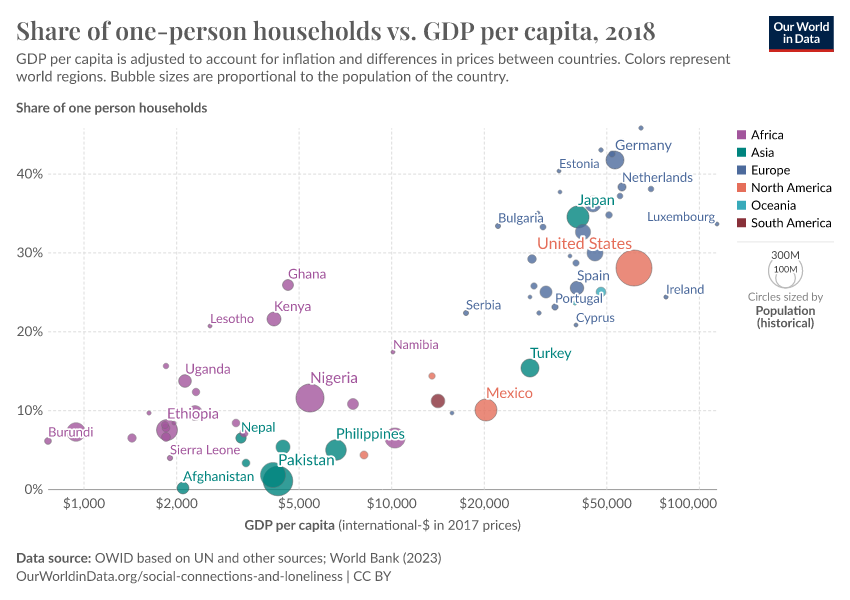
Is the rise of one-person households a problem?
Social connections – including contact with friends and family – are important for our health and emotional well-being. Hence, as the ‘rise of living alone’ continues, there will be new challenges to connect people and support those living alone, particularly in poorer countries where communication technologies are less developed and welfare states are weaker.
But it’s also important to remember that living alone is not the same as feeling lonely. There’s evidence that living alone is, by itself, a poor predictor of loneliness. Self-reported loneliness has not been growing in recent decades. In fact, the countries where people are most likely to say they have support from family and friends are the same countries – in Scandinavia – where a large fraction of the population lives alone.
Incomes and freedom of choice are not the only drivers of the ‘rise of living alone’; but it would be remiss to ignore they do contribute to this trend.
Higher incomes, economic transitions that enable migration from agriculture in rural areas into manufacturing and services in cities, and rising female participation in labor markets all play a role. People are more likely to live alone today than in the past partly because they can increasingly do so.
Key Charts on Loneliness & Social Connections
See all charts on this topicEndnotes
There are dozens of articles reporting the ‘15 cigarettes a day’ figure. See, for example this in The Daily Mail. All the articles that cite this figure trace back to Dr. Vivek Murthy and a meta-analysis by Holt-Lunstad et al. (2015), which we discuss in more detail below. When reviewing this meta-analysis, we found the claim that loneliness is a risk factor comparable to smoking, but we could not find the calculations that lead to the 15 cigarettes benchmark. It’s still unclear to me what the unit of loneliness is and what this translates into in terms of years of lives lost. However, given that 15 cigarettes per day are about the average consumption among smokers, the benchmark may come from comparing excess mortality of smoking for the average smoker vs. excess mortality of loneliness for average levels of loneliness.
The most popular composite index is the UCLA Loneliness Scale, which was first proposed in 1978 and is based on a 20-item scale designed to measure subjective feelings of loneliness. You can read more about it here.
Penninx, B. W., Van Tilburg, T., Kriegsman, D. M., Deeg, D. J., Boeke, A. J. P., & van Eijk, J. T. M. (1997). Effects of social support and personal coping resources on mortality in older age: The Longitudinal Aging Study Amsterdam. American journal of epidemiology, 146(6), 510-519.
Holt-Lunstad, J., Smith, T. B., Baker, M., Harris, T., & Stephenson, D. (2015). Loneliness and social isolation as risk factors for mortality: a meta-analytic review. Perspectives on psychological science, 10(2), 227-237.
Hawkley, L. C., & Cacioppo, J. T. (2010). Loneliness matters: A theoretical and empirical review of consequences and mechanisms. Annals of behavioral medicine, 40(2), 218-227.
Pinker, S. (2015). The village effect: How face-to-face contact can make us healthier and happier. Vintage Canada.
Cole, S. W., Hawkley, L. C., Arevalo, J. M., & Cacioppo, J. T. (2011). Transcript origin analysis identifies antigen-presenting cells as primary targets of socially regulated gene expression in leukocytes. Proceedings of the National Academy of Sciences, 108(7), 3080-3085.
Two concrete papers that show this is a real concern are:
- Abdellaoui, A., Sanchez-Roige, S., Sealock, J., Treur, J. L., Dennis, J., Fontanillas, P., … & Baselmans, B. (2018). Phenome-wide investigation of health outcomes associated with genetic predisposition to loneliness. bioRxiv, 468835.
-Abdellaoui, A., Chen, H. Y., Willemsen, G., Ehli, E. A., Davies, G. E., Verweij, K. J., … & Cacioppo, J. T. (2019). Associations between loneliness and personality are mostly driven by a genetic association with neuroticism. Journal of personality, 87(2), 386-397.
If you know of relevant studies that do provide such estimates, please let me know at esteban@ourworldindata.org.
For historical context: The Harvard Graduate School of Education – the first to admit women – opened admissions to women in 1920, and the Harvard Medical School accepted its first female enrollees in 1945, even though the first woman applied in 1847. You can read more about the hard-earned gains for women at Harvard here: https://news.harvard.edu/gazette/story/2012/04/hard-earned-gains-for-women-at-harvard/
The original participants for this study came from two groups: a cohort of 268 men, 19 years of age, from the Harvard classes of 1939-1944; and a group of 456 caucasian men, ages 11-16, from underprivileged neighborhoods of Boston. Over the years, the project evolved, enrolling more participants, and many of the children of the original participants are included in the study today.
The question on frequency of interaction with friends was asked in the context of time spent at work, clubs or places of worship. The options included ‘weekly’, ‘once or twice a month’, ‘only a few times a month’, and ‘not at all’. The options for happiness, on the other hand, included ‘very happy’, ‘quite happy’, ‘not very happy’, and ‘not at all happy’. In the chart, we took this data and split the sample in two: we classified respondents as ‘often meeting with friends’ if they said they met with friends once a month or more frequently, and we classified them as ‘rarely meeting with friends’ if they said they met with friends ‘once a year’ or ‘not at all’. Then, for each of these two groups, we plotted the share who reported being ‘very happy’ or 'quite happy’.
The estimates have, of course, a margin of error that varies with the survey size. The difference between the green and blue dots is statistically significant for about half of the countries (i.e., for about half of the countries in this chart, the 95% confidence intervals around the blue and green dots would not overlap).
Waldinger, R. J., Cohen, S., Schulz, M. S., & Crowell, J. A. (2015). Security of attachment to spouses in late life: Concurrent and prospective links with cognitive and emotional well-being. Clinical Psychological Science, 3(4), 516-529.
See for example:- Cacioppo, J. T., Hawkley, L. C., & Thisted, R. A. (2010). Perceived social isolation makes me sad: 5-year cross-lagged analyses of loneliness and depressive symptomatology in the Chicago Health, Aging, and Social Relations Study. Psychology and aging, 25(2), 453.- Cacioppo, J. T., Hughes, M. E., Waite, L. J., Hawkley, L. C., & Thisted, R. A. (2006). Loneliness as a specific risk factor for depressive symptoms: cross-sectional and longitudinal analyses. Psychology and aging, 21(1), 140.
The researchers used an open question: “What could you do to ensure that you will be more satisfied in the future?”. There are, of course, many types of answers that people can provide to such an open-ended question, so the authors decided to classify each individual answer into one of two categories, depending on whether or not the respondents described a ‘socially engaged strategy’. This process of classifying answers could naturally raise questions: the authors could manipulate the subjective classification of answers to fit their favorite hypothesis. In order to insure themselves against this criticism, the researchers relied on three independent coders, and they stipulated the classification method and the expected results in a pre-analysis plan. You find more details in the paper: Rohrer, J. M., Richter, D., Brümmer, M., Wagner, G. G., & Schmukle, S. C. (2018). Successfully striving for happiness: Socially engaged pursuits predict increases in life satisfaction. Psychological science, 29(8), 1291-1298.
The key point to remember is that we are not talking about experimental evidence. People who frequently interact with friends or people who say they want to engage more in ‘social strategies to improve their lives’ are likely different. Although the researchers do try to control for this, it is very hard to measure all the relevant characteristics that might help drive life satisfaction. Similarly, asking people about strategies to improve their lives is difficult. Although the qualitative strategy from the paper above is interesting, it’s still hard to draw accurate comparisons: it’s possible that ‘non-social’ strategies, for example, are more difficult or stressful to pursue; so part of the lower apparent impact that these strategies have on happiness might come from the fact that some people are trying but failing to find a better job.
Snell, K. D. M. (2017). The rise of living alone and loneliness in history. Social History, 42(1), 2-28.
The percentage of single-person households is a proxy for ‘solitary living’. However, it’s important to emphasize that these two things are not really the same. Single-person households include those where a person lives alone in an individual housing unit, but they also include people who live independently as lodgers in a separate room within a larger housing unit with other occupants. So technically, there are some people who live in a ‘single-person household’, but they don’t really live alone.
Cite this work
Our articles and data visualizations rely on work from many different people and organizations. When citing this topic page, please also cite the underlying data sources. This topic page can be cited as:
Esteban Ortiz-Ospina (2020) - “Loneliness and Social Connections” Published online at OurWorldinData.org. Retrieved from: 'https://ourworldindata.org/social-connections-and-loneliness' [Online Resource]BibTeX citation
@article{owid-social-connections-and-loneliness,
author = {Esteban Ortiz-Ospina},
title = {Loneliness and Social Connections},
journal = {Our World in Data},
year = {2020},
note = {https://ourworldindata.org/social-connections-and-loneliness}
}Reuse this work freely
All visualizations, data, and code produced by Our World in Data are completely open access under the Creative Commons BY license. You have the permission to use, distribute, and reproduce these in any medium, provided the source and authors are credited.
The data produced by third parties and made available by Our World in Data is subject to the license terms from the original third-party authors. We will always indicate the original source of the data in our documentation, so you should always check the license of any such third-party data before use and redistribution.
All of our charts can be embedded in any site.
